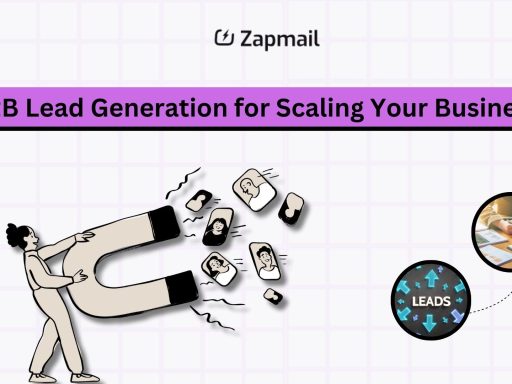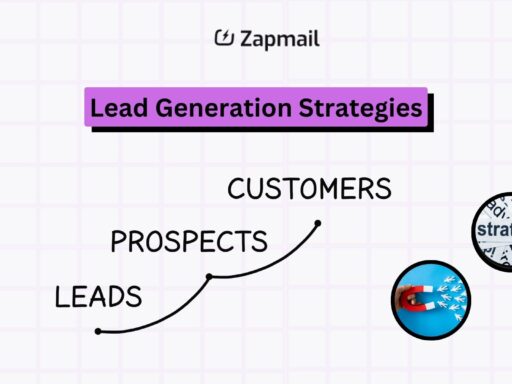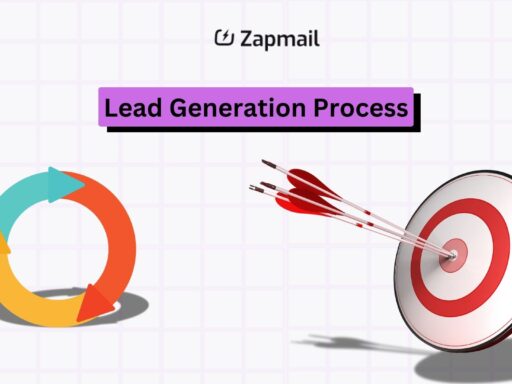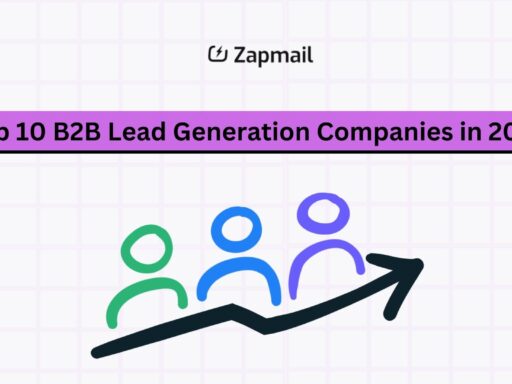Lead generation is about finding and drawing in people who might be interested in what you offer. It’s a key step in marketing or sales. It helps businesses get a list of people who might buy from them. As technology changes, lead generation will keep being important for growing businesses.
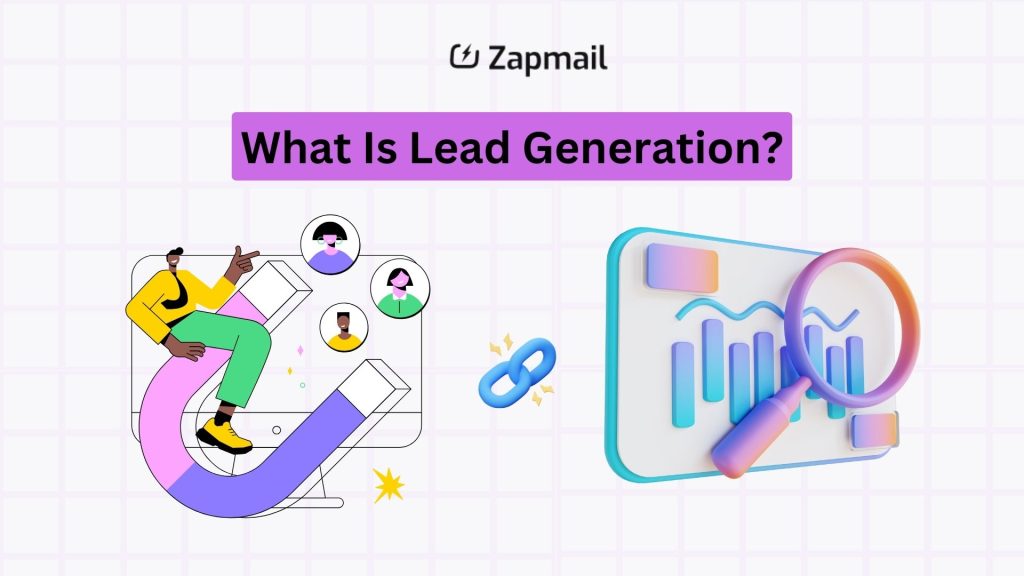
Key Takeaways
- Lead generation is the process of identifying and attracting potential customers with an interest in your products or services.
- It is a vital first step in a marketing or sales strategy, helping businesses build a pipeline of qualified leads.
- Lead generation will remain crucial for business growth in 2025 and beyond as the digital landscape continues to evolve.
- The three best lead sources for B2B companies are customer referrals, LinkedIn Sales Navigator, and web scraping tools.
- B2B and B2C businesses receive leads from different sources, with B2B relying more on referrals and B2C on traditional advertising and social media.
Introduction to Lead Generation
Lead generation is key to any successful marketing and sales plan. It helps businesses find, attract, and qualify potential customers. This leads to more sales and revenue growth. It also boosts brand awareness and makes sales processes more efficient.
what is lead generation?
Lead generation is about finding and attracting people who might be interested in what you offer. It’s a key step in marketing and sales. It helps businesses get a list of people who might buy their products or services.
To get leads, you can use many methods. These include making content, using social media, and automation tools. Knowing how to generate leads is important for growing your business and making more sales.
Studies show that 39% of B2B marketers get leads from Facebook, 30% from Twitter, and 44% from LinkedIn. These platforms are great for reaching your audience, sharing content, and building relationships that can lead to sales.
Lead generation is crucial for a brand’s growth. It involves using strategies like nurture campaigns, SEO, and landing pages. These help guide potential customers through the sales process and boost your chances of making a sale.
Importance of Lead Generation in Marketing
In today’s market, lead generation is vital. With so much information available, businesses must stand out. Lead generation offers a way to do this by guiding the process of finding and nurturing potential customers. This leads to more sales and revenue.
The Lead Generation Process
The lead generation process has several steps. It starts with attracting potential customers through marketing. Then, it captures their information and qualifies them. Finally, it nurtures them through the sales funnel. The exact process varies by industry and target audience.
Key Types of Leads
Leads are categorized based on their interest and readiness to buy. There are three main types:
- Cold leads: People who haven’t shown interest yet.
- Warm leads: Those who have shown some interest, like visiting the website.
- Hot leads: Prospects ready to talk to sales reps.
Knowing these lead types helps in creating targeted strategies. This is crucial for growing the business.
Effective Strategies for Lead Generation in 2025
Marketing and sales are changing fast. To lead the pack, businesses must use new strategies and tech. Content marketing and social media will keep being key. Automation and AI will also be crucial.
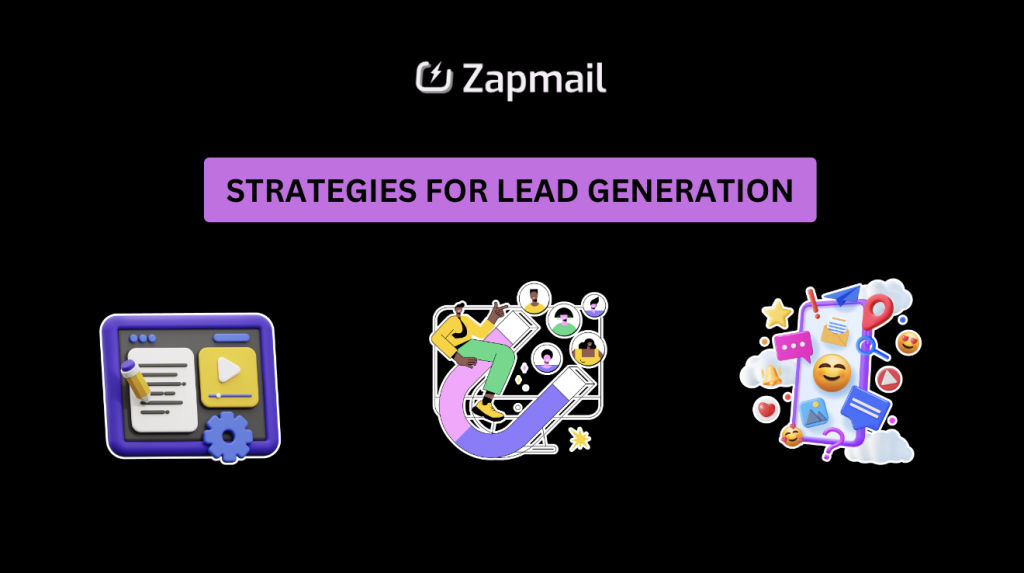
Content Marketing for Lead Generation
Content marketing is still a top strategy in 2025. Companies will use valuable content to draw in and keep customers. This includes blog posts, whitepapers, and videos that meet the audience’s needs.
By offering great content, businesses can show they know their stuff. This builds trust and brings in quality leads.
Social Media Lead Generation
Social media is vital for lead generation in 2025. Companies will use LinkedIn, Facebook, and Twitter to connect with their audience. They’ll run ads, join discussions, and partner with influencers.
This way, they can reach more people and grab the attention of potential leads. It’s a smart way to use social media for lead generation.
Automation Tools for Lead Generation
Automation tools will be key for lead generation in 2025. CRM systems, marketing automation, and lead capture tools will help streamline processes. They automate tasks like lead scoring and nurturing.
This lets sales and marketing teams focus on activities that boost sales and growth.
Measuring Success with KPIs
It’s key to measure lead generation success to make smart decisions. Businesses should watch key performance indicators (KPIs). This helps understand what works best and where to focus.
Some important lead generation KPIs include:
- Lead volume: The total number of leads from different marketing channels.
- Lead-to-opportunity ratio: The percentage of leads that turn into sales opportunities.
- Lead-to-customer conversion rate: The percentage of leads that become paying customers.
- Cost per lead: The average cost to get a new lead through marketing.
By keeping an eye on these metrics, businesses can find the best lead generation methods. They can also see where they need to get better. For instance, tracking the cost per lead helps make marketing campaigns more efficient. The lead-to-customer conversion rate shows how good the leads are.
HubSpot’s 2021 State of Marketing Report shows that nearly 35% of marketers focus on lead generation. The number of quality leads is a key metric for both marketing and sales teams.
Trends Shaping Lead Generation in 2025
The marketing world is changing fast. By 2025, two big trends will shape lead generation. These are Artificial Intelligence (AI) and the need for better data privacy.
The Role of AI in Lead Generation
AI tools will change how we get leads. They can look at lots of data, find patterns, and tailor messages. This makes lead generation better and more efficient.
AI will help with things like scoring leads and keeping them interested. By 2025, AI will do even more to help businesses get leads. It will make decisions based on data, not just guesses.
Data Privacy and Lead Generation
Data privacy is becoming a big deal. Lead generation in 2025 will have to follow new rules and listen to what people want. Businesses must be open, get clear consent, and follow laws like GDPR.
Keeping data safe and being honest with leads is key. Companies that care about privacy will attract better leads. They will earn trust and succeed in lead generation.
Lead Generation through Cold Emailing
Cold emailing is a key strategy in lead generation. It’s effective and affordable for reaching out to professionals and decision-makers. With a 15% conversion rate, it can grow your business and bring in valuable leads.
Tools like Reachinbox and Zapmail make cold emailing easier. They offer email automation, personalization, and better delivery. This helps you reach more people while following the rules.
ReachInbox: Your Comprehensive Cold Email Solution
ReachInbox is designed to optimize your cold email outreach, making it easier to connect with potential leads while maintaining compliance with relevant regulations. Here’s what it offers:
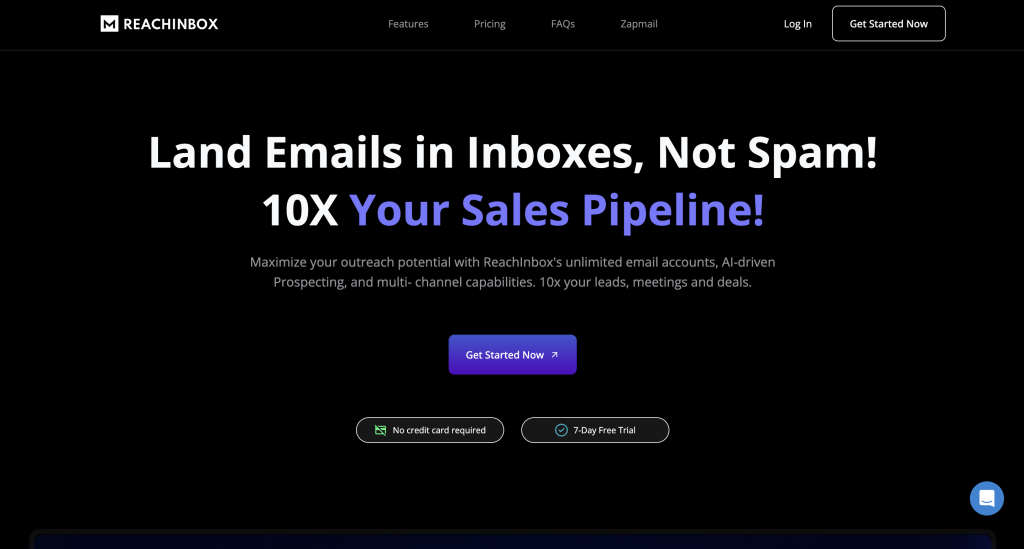
• Email Automation and Personalization: Streamline your email campaigns with automation tools that allow you to personalize your outreach. This saves you time and ensures your messages resonate with your audience.
• Deliverability Optimization: ReachInbox focuses on ensuring your emails reach the intended inboxes, minimizing the chances of being marked as spam. Improved deliverability leads to better open and response rates.
• Regulatory Compliance: With regulations like the FCC’s lead generator loophole law, ReachInbox helps you stay compliant, protecting your business from potential legal issues while building trust with your audience.
• In-Depth Analytics: Access detailed analytics and insights that allow you to refine your lead generation strategies. Monitor performance metrics to understand what works best and make informed decisions.
As email usage continues to rise, projected to reach 376 billion daily by 2025, having a reliable tool like ReachInbox is crucial for successful cold emailing.
Zapmail: Your Streamlined Email Management Tool
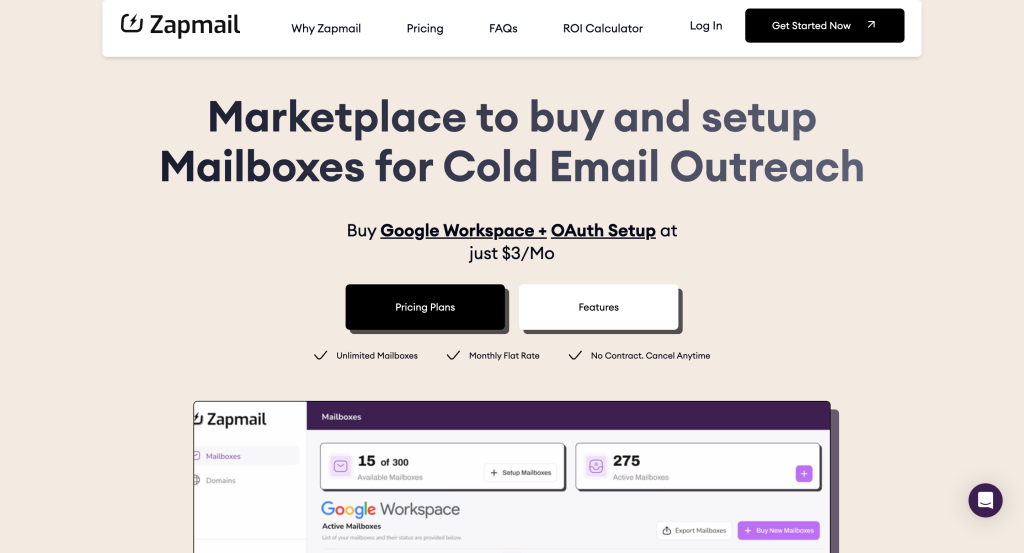
Zapmail is a powerful platform designed to streamline the management of email communications and enhance your outreach efforts. Here’s how Zapmail can benefit your business:
• Affordable Email Setup: Zapmail simplifies the process of buying and setting up mailboxes. Users can quickly set up hundreds of mailboxes in just three easy steps: easy mailbox setup, connecting domains, and exporting mailboxes to tools like Instantly, ReachInbox, Smartlead and Reply.
• Automated Mailbox Management: Zapmail automates the configuration of mailboxes with essential settings like SPF and DMARC records, ensuring secure and effective email delivery.
• User-Friendly Interface: The platform provides an intuitive interface that makes it easy to manage your mailboxes, ensuring you can focus on engaging with prospects rather than getting bogged down by technical details.
• Seamless Domain Management: Users can buy new domains or transfer existing ones to manage all their email needs within Zapmail. This flexibility allows for streamlined operations and easier oversight.
• Enhanced Deliverability: By managing email infrastructure effectively, Zapmail helps improve the deliverability of your outreach emails, increasing the likelihood of your messages reaching the intended recipients.
With email communication expected to reach 376 billion daily by 2025, utilizing a robust solution like Zapmail is essential for businesses looking to optimize their email outreach and stay competitive in the market.
Understanding Your Target Market for Lead Generation
Effective lead generation starts with knowing your target market well. By creating an Ideal Customer Profile (ICP) and doing deep audience research, businesses can find out who their best potential leads are. This info is key for making lead generation strategies that work, creating offers that appeal, and making sure marketing and sales are aimed at the right people.
To get a better grasp of your target market for lead generation, follow these steps:
- Look at your current customer data to find out what makes your best customers tick. This helps you create your ICP and focus on the right people for lead generation.
- Do market research to learn about your target audience’s challenges, needs, and likes. Use surveys, interviews, and industry data to get valuable insights.
- Use social media and online communities to talk to your target audience, get feedback, and understand their interests and problems. This helps shape your content and lead nurturing plans.
By really getting to know your target market, you can make your lead generation better. This leads to more successful marketing and sales, higher conversion rates, more valuable customer relationships, and business growth.
Setting Clear Goals for Lead Generation
Setting clear and measurable goals is key for lead generation success. Businesses should aim for specific targets like revenue goals or new customer numbers. These goals should match the company’s overall aims and be checked often to see if they’re working.
When setting lead generation goals, use the SMART framework. This means the goals should be Specific, Measurable, Achievable, Relevant, and Time-bound. This makes sure goals are clear, trackable, and can be reached within a set time.
- Specific: Clearly state what you want to achieve, like a certain number of new leads.
- Measurable: Pick metrics to track progress, like conversion rates or lead costs.
- Achievable: Make goals challenging but realistic based on what you can do.
- Relevant: Make sure lead gen objectives fit with your business and marketing plans.
- Time-bound: Set a specific time frame to reach your goals, like a quarter or year.
By using SMART lead generation goals, businesses can see how well their marketing is doing. They can spot what needs work and make smart choices to improve their lead generation.
Creating a Compelling Value Proposition
To attract high-quality leads and convert them into loyal customers, businesses must craft a compelling value proposition. This value proposition should clearly communicate the unique benefits, features, and solutions your company offers. It should address the specific needs and pain points of your target audience.
By developing a value proposition that resonates with potential leads, you can differentiate your business from competitors. This increases the likelihood of generating leads that are more likely to convert. This is crucial for effective lead generation and driving business growth.
- 82% of customers cited limited visibility into operations as a top frustration.
- 45% of customers said managing disparate systems caused significant inefficiencies.
- Automated workflows process requests 45% faster than manual methods competitors rely on.
- Specific cost savings from process improvements: customers reduce operating expenses by an average of 28%.
- Revenue growth: Clients see an average of 59% revenue growth in the first year after implementation.
- Time savings: Software saves users 42 minutes per task, freeing up capacity.
- Increase in customer lifetime value: LTV increases by 22% due to improved retention our platform enables.
- Without automation, users lose 357 hours per year on redundant data entry.
- According to Forrester, companies lose $23M annually from supply chain blind spots.
A compelling value proposition for lead gen should be based on a deep understanding of your target market. It should understand their needs and the unique value your business can provide. Gather insights from customer interviews, surveys, and lead generation forms to identify the key factors that influence their decision-making.
By crafting a unique value proposition for lead generation that highlights your company’s distinctive strengths, you can effectively attract and convert more high-quality leads. This drives business growth and success.
The Impact of the FCC’s Lead Generator Loophole Law
The Federal Communications Commission (FCC) has brought in new rules. These rules, known as the FCC lead generator loophole law, will change lead generation in 2025 and later. They aim to protect consumers better and stop illegal text messages and robocalls. Businesses will need to change how they get leads.
Key Requirements of the New Law
The FCC’s lead generator loophole law has several main rules for businesses. These include:
- One-to-one consent: Businesses must get written consent from consumers for each seller. This is different from a general consent for many entities.
- Clear and conspicuous disclosure: Businesses must tell consumers clearly about the robotexts and robocalls they will get.
- Topically and logically related outreach: The contact made by the business must be related to the consumer’s initial inquiry. This is where consent was given.
- Recordkeeping: Businesses must keep detailed records of the consumer’s consent. These records can be asked for by the caller/sender to show they followed the rules.
These new FCC lead generation rules aim to protect consumers from unwanted messages. They also require businesses to be more open and responsible in their lead generation. Following the FCC lead generator loophole law is key for businesses. It helps them avoid penalties and keep their customers’ trust.
Preparing for the Lead Generator Loophole Law
Businesses need to get ready for the FCC’s lead generator loophole law in 2025. This law aims to fix a loophole that lets companies get leads without full consent. It’s important to act now to follow the new rules.
Businesses should learn about the new law’s details. They need to know about “one-to-one” consent for calls and texts. They also need to understand rules on lead forms and buying leads across different areas.
It’s also key to check on vendor relationships. Make sure lead generation partners follow the new rules. This might mean looking at how they handle consent and checking if they’re following the law.
Investing in tools for managing consent is a good idea. These tools help track leads and keep records. This way, companies can avoid legal trouble and show they care about their customers’ privacy.
By taking these steps, businesses can get ready for the new law. They can change their lead generation ways to follow the rules. This helps them avoid legal issues and shows they value their customers’ trust.
Lead Generation Strategies for Compliance
In today’s world, lead generation is key for any business to succeed. But with the FCC’s new rules, companies must follow strict guidelines. This ensures their lead generation is both compliant and ethical.
Obtaining One-to-One Consent
The FCC now requires businesses to get written consent from consumers for each seller. This means one consent can’t cover all telemarketers or partners. Companies must have a clear lead gen consent process that lets consumers know who they’re giving permission to contact.
Monitoring Publisher Compliance
Businesses that use lead publishers and vendors must watch their partners closely. They need to check if these partners follow the FCC’s rules. This includes looking at their lead gen tactics for TCPA compliance and how they document things.
By keeping a close eye on their lead sources, businesses can avoid getting non-compliant leads. This helps keep their marketing and sales efforts legal.
By following these steps, businesses can keep generating quality leads while following the new rules. They’ll make sure their one-to-one consent lead generation, vendor compliance for lead gen, and monitoring lead publisher compliance are all up to date with the FCC’s rules.
The Future of Comparison Shopping Sites
The FCC’s new law will change how comparison shopping sites work. These sites share consumer data with many companies. Now, they must ask for permission before sharing this data with specific sellers.
These sites will have to change how they get leads. They might ask people to choose which businesses they want to hear from. This change will affect small businesses that rely on these sites for leads.
Comparison shopping sites have made a lot of money worldwide. But, the FCC’s new rule, expected by mid-2024, will be a challenge. Small businesses might spend more on getting leads and have fewer leads from third-party sites.
To keep up, sites and businesses will need to find new ways to get leads. They might create their own lead engines or focus on specific products. By being flexible and adapting to new rules, they can thrive in the changing world of comparison shopping.
Lead Publisher Responsibilities
With the FCC’s new law, lead publishers have more duties. They must clearly show, get, and keep records of consumer consent. This ensures that consent is easy to understand and well-documented.
By doing this, lead publishers help their partners stay in line. They also keep getting good leads.
Refining Consent-Gathering Practices
Lead publishers need to look at their consent methods closely. They should make sure disclosures are clear and easy to see. The consent process should be simple for consumers.
They also need to keep detailed records of consent. This way, they help their partners deal with changing rules. And they keep getting valuable leads.
Lead publishers must focus on lead publisher compliance, lead gen publisher best practices, and the responsibilities of lead gen publishers. They need to improve consent capture for lead gen and strengthen lead publisher consent practices. Using consent-focused lead gen strategies is key to staying compliant and getting quality leads.
TrustedForm Solutions for Lead Generation
TrustedForm is a top name in compliance solutions. They offer innovative products and services for businesses in the lead generation world. Whether you’re buying or publishing leads, TrustedForm helps you work better, stay compliant, and achieve your goals.
Solutions for Lead Buyers
Lead buyers get tools from TrustedForm to stay on top of compliance. This helps avoid legal and financial risks. It also lets you make smart choices about the leads you buy.
- Storing and visually representing consumer consent certificates
- Real-time lead analysis to identify potential compliance issues
- Leveraging third-party data services to flag TCPA litigators, fraud, and other risk factors
With TrustedForm’s tools, lead buyers can handle changing rules with confidence. You can focus on getting quality, compliant leads that grow your business.
Solutions for Lead Publishers
Lead publishers get help from TrustedForm to improve how they get consent. This ensures they follow the FCC’s rules. The tools help you:
- Design clear and conspicuous disclosures
- Making the consent process easy for consumers to understand and complete
- Maintaining comprehensive documentation of the consent transaction
By using TrustedForm’s solutions, lead publishers can keep generating quality leads. This protects their reputation and reduces legal risks.
TrustedForm certifies over 2.5 billion leads every year. Thousands of businesses and customers worldwide rely on them for lead generation and compliance. They are a key player in the lead generation world.
Conclusion
We’ve looked at how lead generation is changing, focusing on 2025 and beyond. We’ve talked about why lead generation is key in marketing and the FCC’s new rules. These are important for businesses to know and act on.
Using the right lead generation strategies and new tech can help businesses grow. They need to understand their market, make engaging content, and use many channels to promote. Also, they should care for their leads to turn them into customers.
As lead generation keeps changing, businesses must stay up-to-date and flexible. By using the tips from this guide, they can succeed in the future. This way, they can make the most of the changing lead generation world.
FAQ
Lead generation is finding and attracting people who might be interested in what you offer. It’s a key step in marketing and sales. It helps businesses find and nurture potential customers.
Lead generation is vital for marketing and sales. It helps businesses find and qualify potential customers. This leads to more brand awareness, better leads, and higher sales.
The lead generation process includes several steps. First, attract potential customers through marketing. Then, capture their information. Next, qualify the leads and nurture them through the sales funnel.
Leads are categorized based on their interest and readiness. Cold leads haven’t shown interest yet. Warm leads have shown some interest. Hot leads are ready to buy.
Effective strategies for 2025 include content marketing and social media outreach. Automation tools also help streamline the process. These methods attract and engage potential customers.
Measuring lead generation success is key. Track KPIs like lead volume and conversion rates. This helps make informed decisions and improve strategies.
Data privacy will shape lead generation in 2025. Businesses must adapt to stricter regulations and consumer expectations. Transparency and consent are essential.
The FCC’s law introduces new rules for lead generation. Businesses must get consent and provide clear disclosures. Outreach must be relevant to the consumer’s inquiry.
